Charles E W Bean, Diaries, AWM38 3DRL 606/270 PART 2/1 - 1918 - 1939 - Part 3
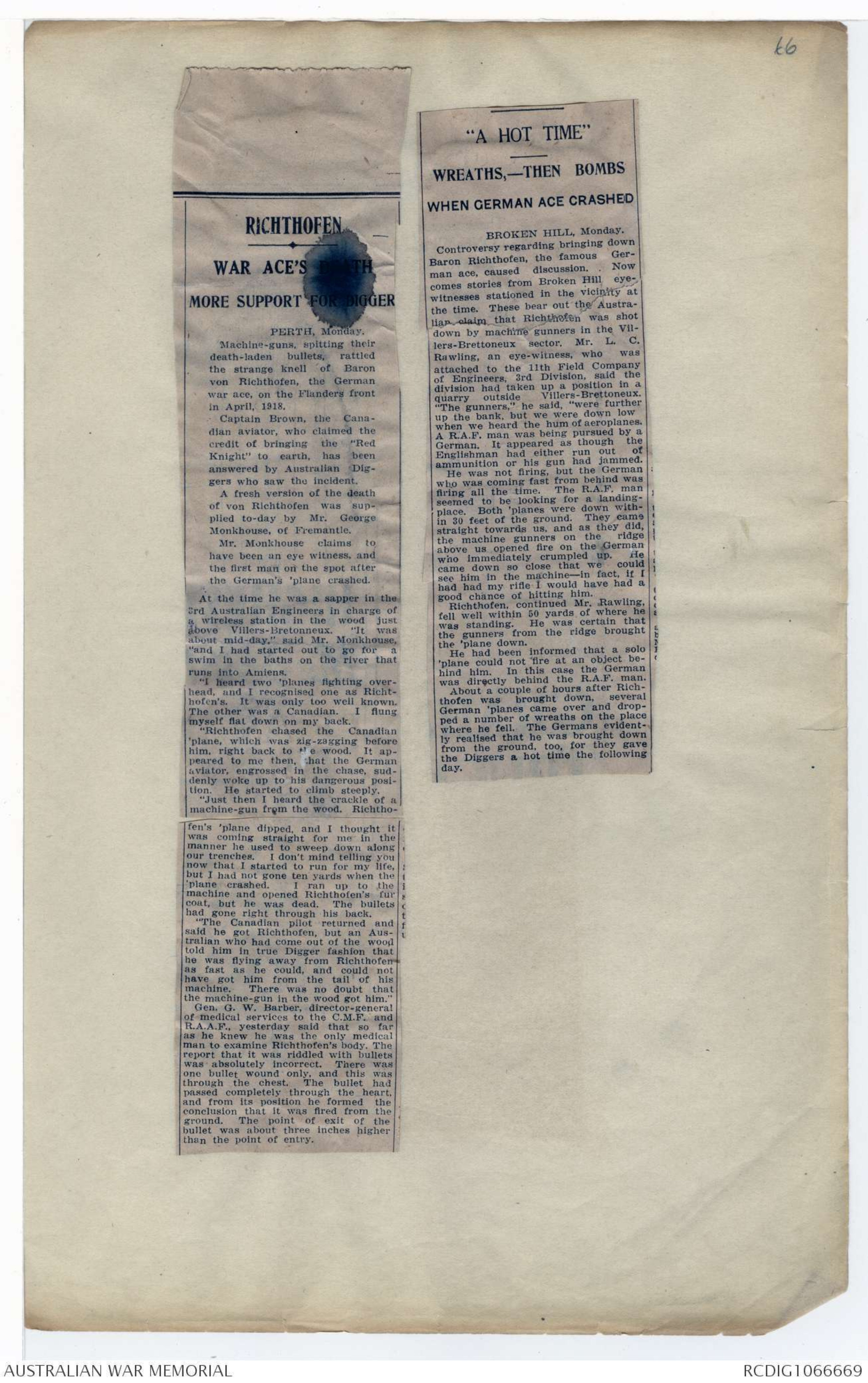

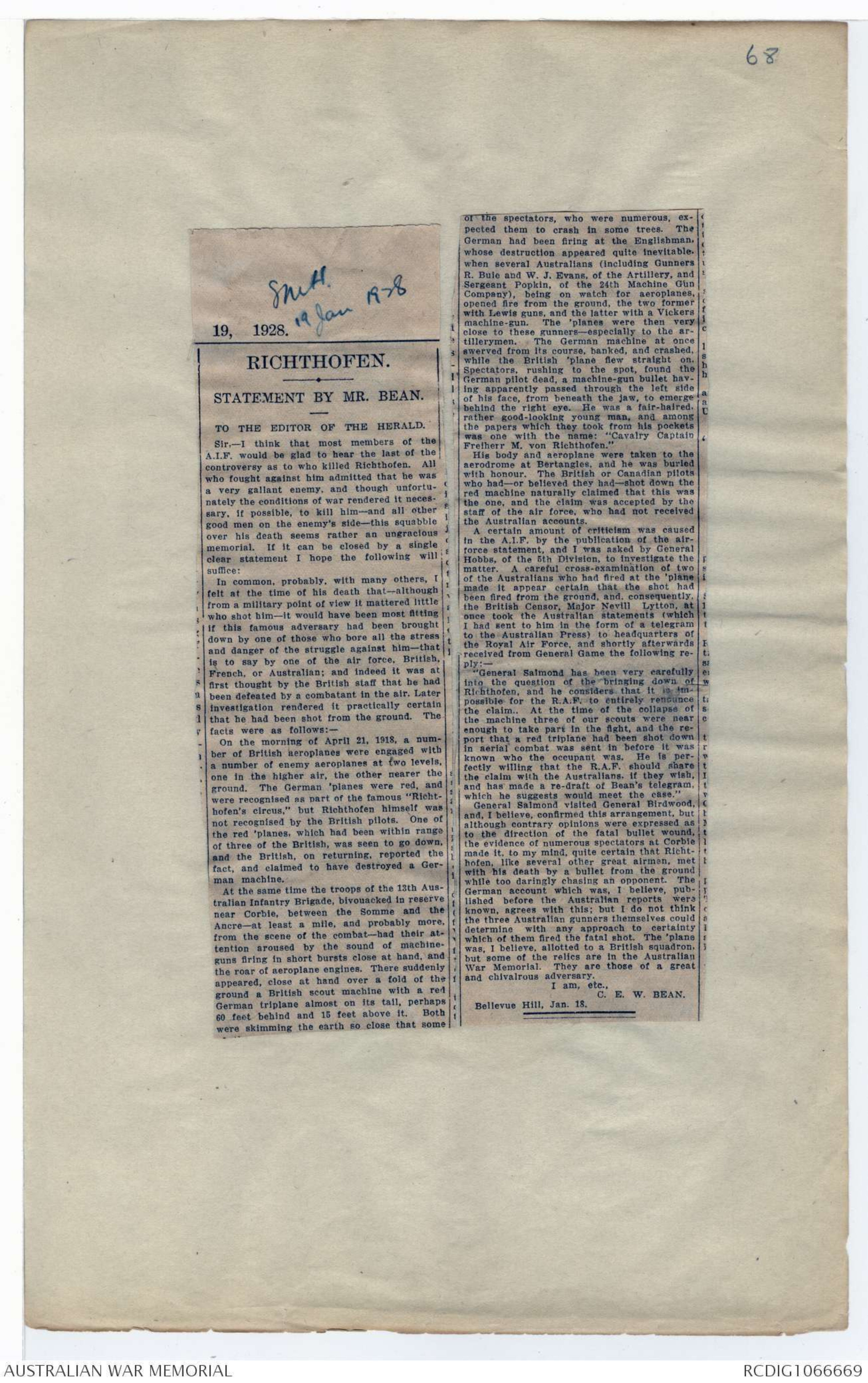
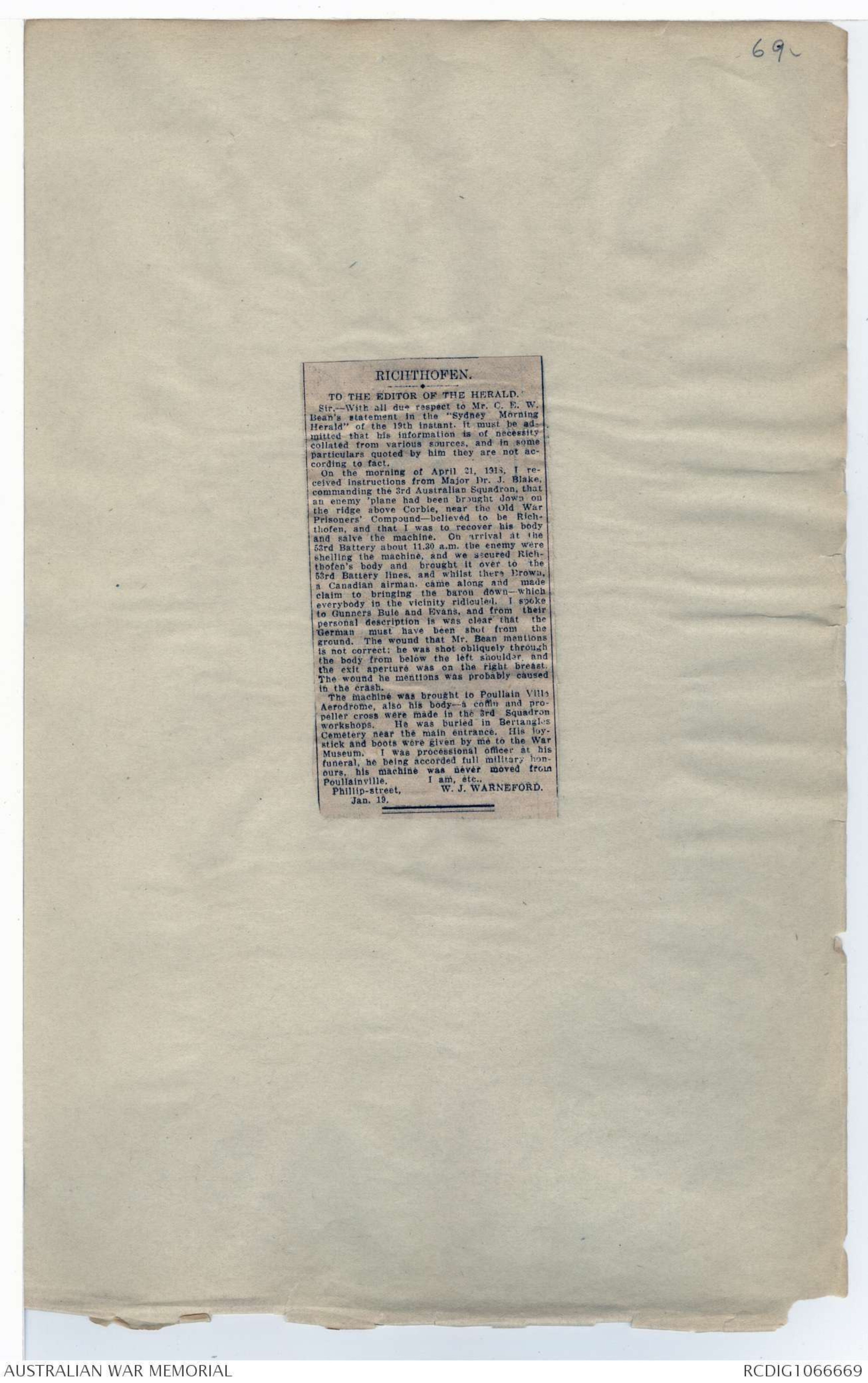
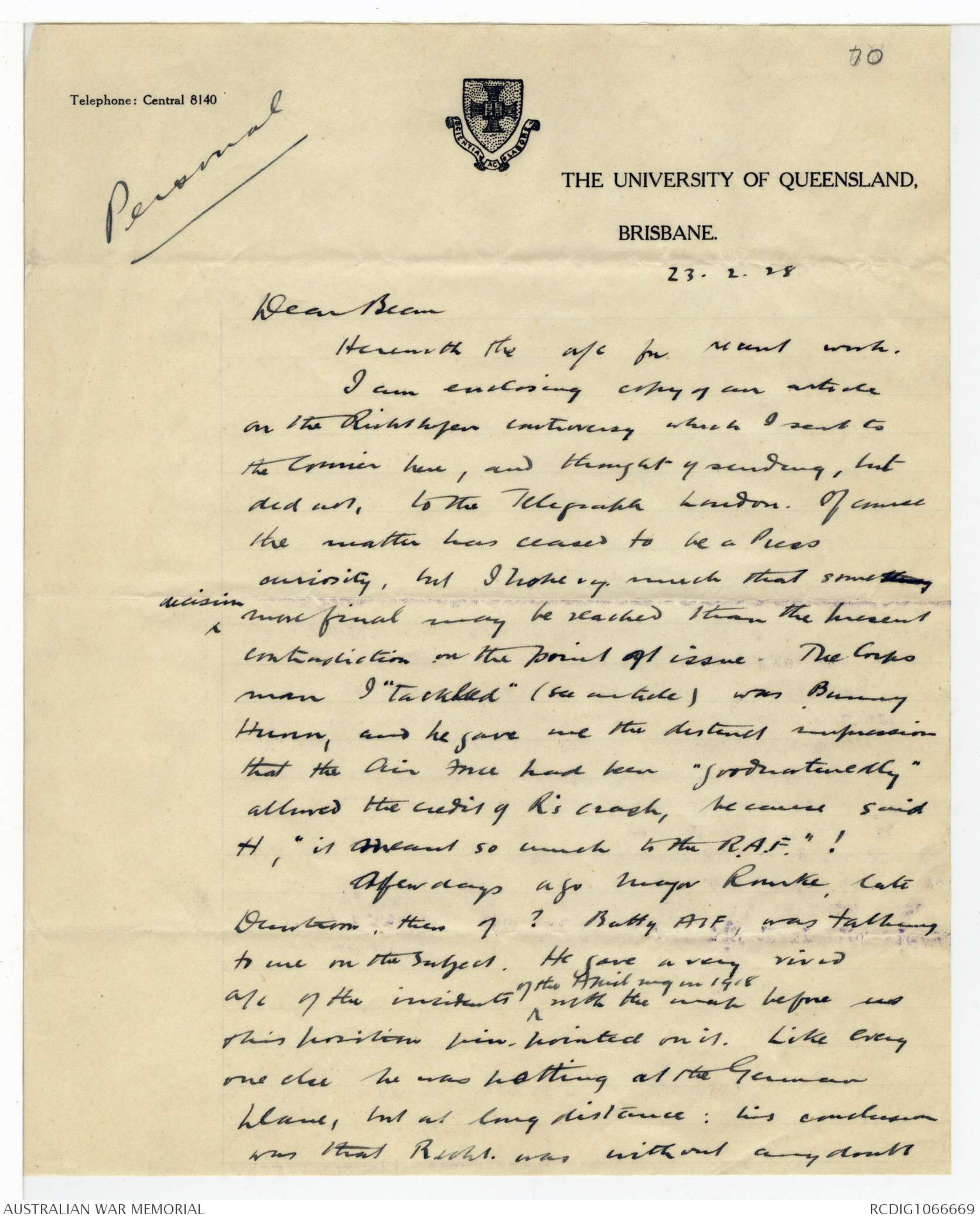
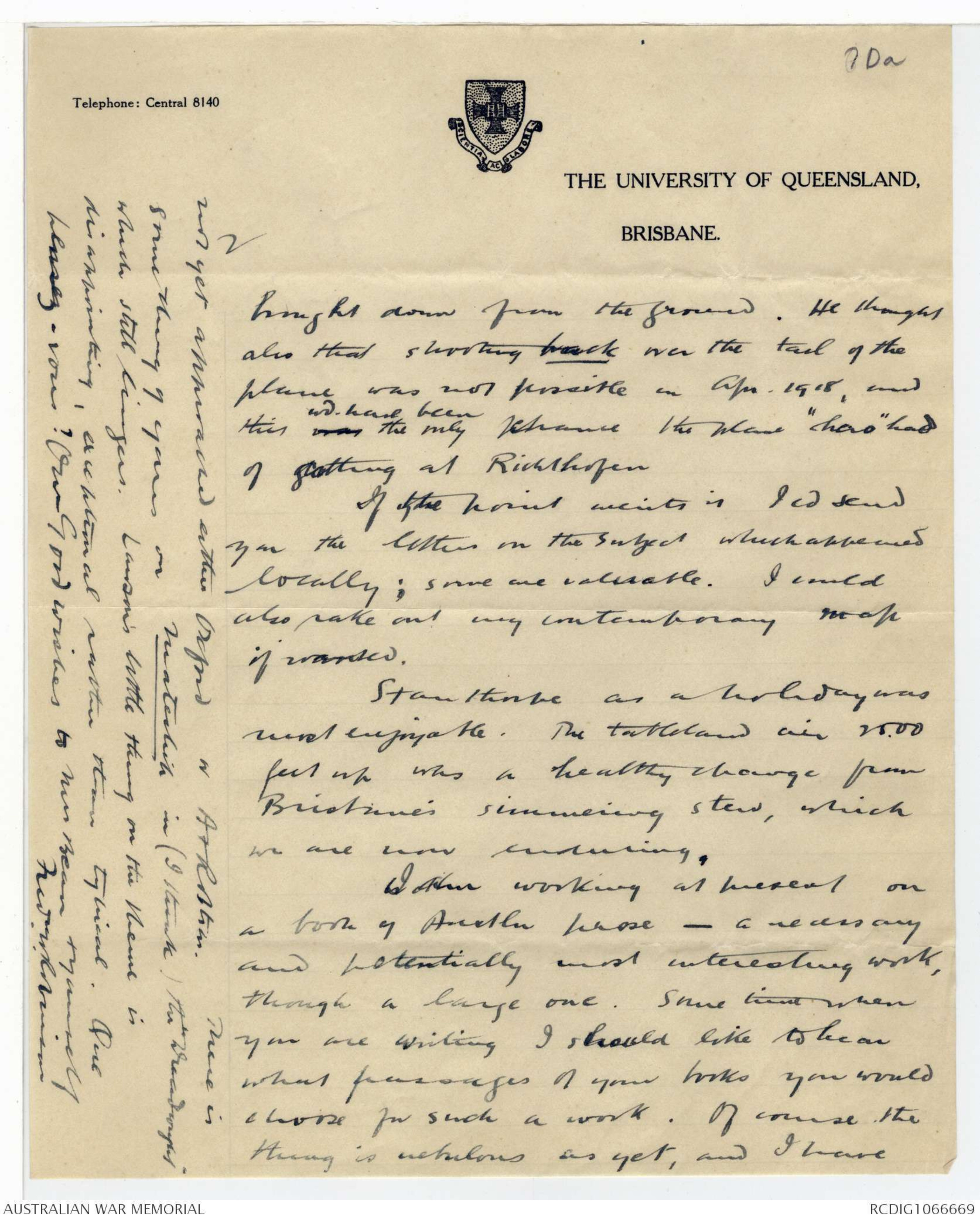
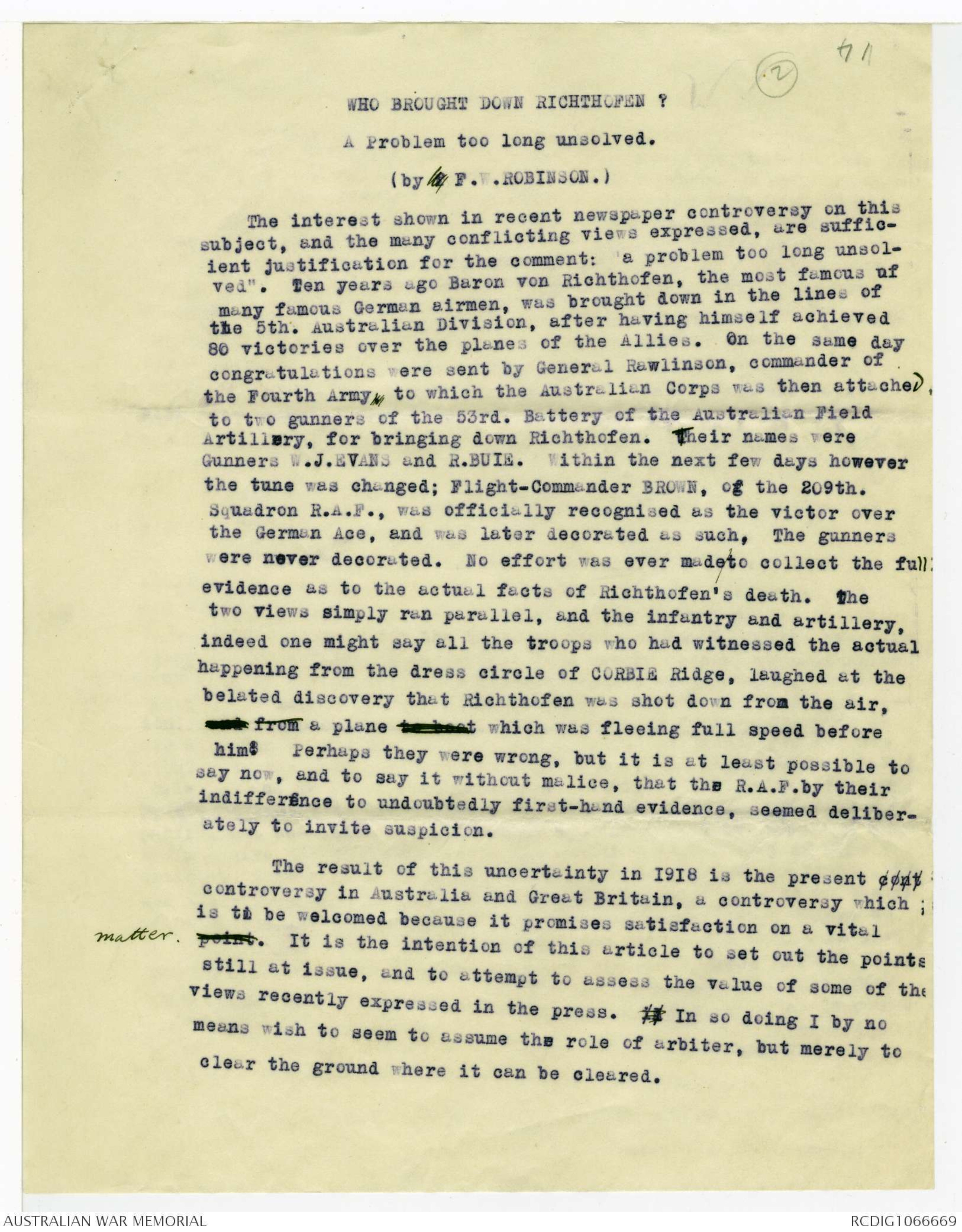

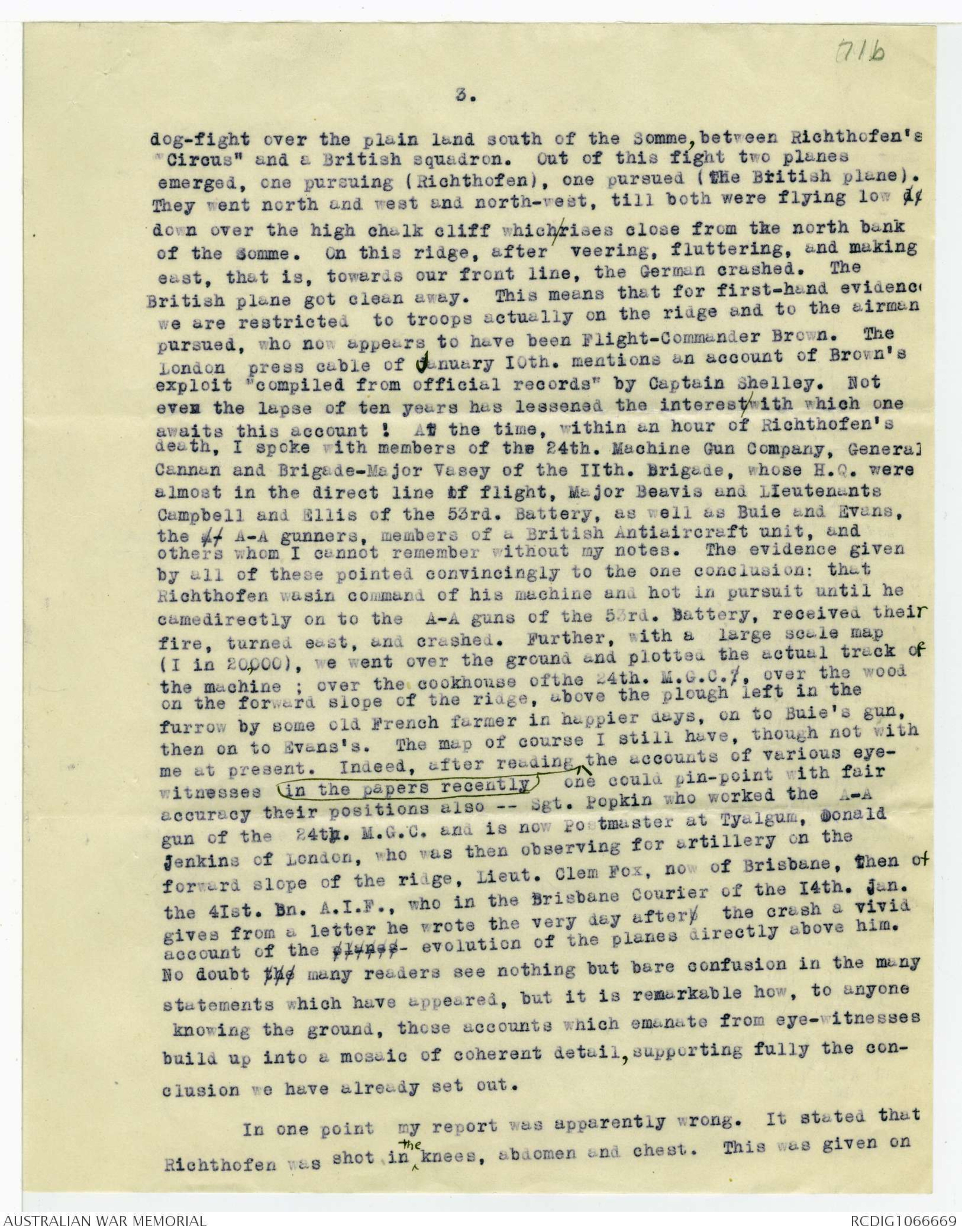

66
'RICHTHOFEN
WAR ACES DEATH
MORE SUPPORT FOR DIGGER
PERTH, Monday.'
See original document.
"A HOT TIME"
WREATHS, - THEN BOMBS
WHEN GERMAN ACE CRASHED
BROKEN HILL, MONDAY. '
See original document
67
[*Sydney D.T.*]
JANUARY 18, 1928.
HOW RICHTHOFEN
WAS
BROUGHT DOWN
"Gunner Who Fired the
Fatal Shot" Tells
His Story
END OF GERMAN ACE.
MURWILLUMBAH, Tuesday.
See original document
68
[*SMH.
19 Jan 1928*]
19. 1928.
RICHTHOFEN.
STATEMENT BY MR. BEAN.
TO THE EDITOR OF THE HERALD.'
See original document
69
'Article:
RICHTHOFEN
TO THE EDITOR OF THE HERALD.'
[by W.J. WARNEFORD. Jan. 19.]
See original document
70
Telephone: Central 8140
THE UNIVERSITY OF QUEENSLAND.
BRISBANE.
23. 2. 28
Personal
Dear Bean
Herewith the a/c for recent work.
I am enclosing copy of an article
on the Richthofen controversy which I sent to
the Courier here, and thought of sending, but
did not, to the Telegraph London. Of course
the matter has ceased to be a Press
curiosity, but I hope very much that something
^decision more final may be reached than the present
contradiction on the point at issue. The Corps
man I "tackled" (see article) was Bunny
Hunn, and he gave me the distinct impression
that the Air Force had been 'goodnaturedly"
allowed the credit of R's crash, because said
H, "it meant so much to the R.A.F."!
A few days ago Major Rourke, late
Duntroon, then of ? Batty AIF was talking
to me on the subject. He gave a very vivid
a/c of the incidents ^of the April mg in 1918 with the map before us
& his position pin-pointed on it. Like every
one else he was potting at the German
plane, but at long distance: his conclusion
was that Richt. was without any doubt
70a
Telephone: Central 8140
THE UNIVERSITY OF OUEENSLAND.
BRISBANE.
brought down from the ground. He thought
also that shooting back over the tail of the
plane was not possible in Apr. 1918, and
and this was wd have been the only chance the plane "hero" had
of getting at Richthofen.
If the point merits it I cd send
you the letters on the subject which appeared
locally; some are valuable. I could
also rake out my contemporary map
if wanted.
Stanthorpe as a holiday was
most enjoyable. The tableland air 2000
feet up was a healthy change from
Brisbane's simmering stew, which
we are now enduring.
I am working at present on
a book of Austln prose - a necessary
and potentially most interesting work
though a large one. Some time when
you are writing I should like to hear
what passages of your books you would
choose for such a work. Of course the
thing is nebulous as yet, and I have
[*not yet approached either Oxford or A&Rbtson There is
something of yours on mateship in (I think) the "Dreadnought"
which still lingers. Lawson's little thing on the theme is
disappointing, exceptional rather than typical. Que
Laissez vous? Our Good wishes to Mrs Bean & yourself
Fred W Robinson*]
71 2
WHO BROUGHT DOWN RICHTHOFEN ?
A Problem too long unsolved.
(by L F.W. ROBINSON.)
The interest shown in recent newspaper controversy on this
subject, and the many conflicting views expressed, are sufficient
justification for the comment: 'a problem too long unsolved".
Ten years ago Baron von Richthofen, the most famous of
many famous German airmen, was brought down in the lines of
the 5th. Australian Division, after having himself achieved
80 victories over the planes of the Allies. On the same day
congratulations were sent by General Rawlinson, commander of
the Fourth Army, to which the Australian Corps was then attached
to two gunners of the 53rd. Battery of the Australian Field
Artillery, for bringing down Richthofen. Their names were
Gunners W.J.EVANS and R.BUIE. Within the next few days however
the tune was changed; Flight-Commander BROWN, of the 209th.
Squadron R.A.F., was officially recognised as the victor over
the German Ace, and was later decorated as such. The gunners
were never decorated. No effort was ever made/to collect the full
evidence as to the actual facts of Richthofen's death. The
two views simply ran parallel, and the infantry and artillery,
indeed one might say all the troops who had witnessed the actual
happening from the dress circle of CORBIE Ridge, laughed at the
belated discovery that Richthofen was shot down from the air,and from a plane to boot which was fleeing full speed before
him. Perhaps they were wrong, but it is at least possible to
say now, and to say it without malice, that the R.A.F. by their
indifference to undoubtedly first-hand evidence, seemed deliberately
to invite suspicion.
The result of this uncertainty in 1918 is the present cont
controversy in Australia and Great Britain, a controversy which;
is to be welcomed because it promises satisfaction on a vitalpoint matter. It is the intention of this article to set out the points
still at issue, and to attempt to assess the value of some of the
views recently expressed in the press. Ff In so doing I by no
means wish to seem to assume the role of arbiter, but merely to
clear the ground where it can be cleared.
71a 2
In April 1918 I was acting as Intelligence Officer attached to the
5th, Australian Division. The duties of this position included the exam;
examination of all enemy prisoners and papers captured on our Divisional
front. On the morning of April 2Ist. a message came through that a
German airman had crushed in our lines. I went up immediately by car
to the ridge N.E. of Corbie to secure the identification. But this I
found had already been gained, and the whole ridge was buzzing with
the amazing news that the crashed airman was none other than Baron
von Richthofen. His papers were with General Cannan, at the H.Q. of
the 11th. Aust. Inf. Brigade, where I looked through them. The plane
was further forward, not far from an old brick chimney-stack, but no
longer approachable, for round it were bursting German shells set
with instantaneous fuzes. Richthofen's body lay under the fuselage of
his red triplane. One feltthat, heroic figure fig as he was, he was
receiving from his people the burial honours of a Viking of the air.
The body was not recovered until nightfall, by the 3rd. Australian
Flying Squadron.
The task for myself now was to collect all the evidence I
could as to the actual course of events leading to the crash. This
was done, and the report was attached as an "annexe" to the Divisional
Intelligence Summary for the 21st. or 22nd. of April. (Unfortunately,
being now on holiday, I am writing from memory several hundred miles
away from my war papers). It is this report, among others, to which
General Sir Talbot Hobbs, who was then in command of the 5th. Division,
referred recentlyin Perth, and it was also used by Mr. Bean in
his despatch at the time. In it the crashing of Richthofen was attributed
to the anti-aircraft Lewis gunners of the 53rd. Battery A.F.A.
_Buie AND and Evans already mentioned. Whatever earlier accident may
have contributed to Richthofen's disaster -- none has yet been made
public, but see below -- I am still convinced that the names of these
two men give the right answer to the question at the head of this
article. Moreover, their credit is great. To stand their ground, to
use their judgment and let the British plane pass, to fire at the rig
right moment and not to fire wildly -- these were no easy things to
do with the Red Dragon making straight for them. The credit is even g
greater if a story is true that I heard but could never check. It is
that one of the gunners heard about a new anti-aircraft sight which
was not yet ready for issue, and made himself one out of an 18-pounder
brass cartridge case. This allowed an accuracy which otherwise.
could not have been attained.
[*Can any reader confirm this story?*]
What were the possible sources of information about Richthofen's
fall on that April morning in 1918? All agree that there was a
71b 3
dog-fight over the plain land south of the Somme, between Richthofen's
"Circus" and a British squadron. Out of this fight two planes
emerged, one pursuing (Richthofen), one pursued (the British plane).
They went north and west and north-west, till both were flying low do
down over the high chalk cliff which/rises close from the north bank
of the Somme. On this ridge, after veering, fluttering, and making
east, that is, towards our front line, the German crashed. The
British plane got clean away. This means that for first-hand evidence
we are restricted to troops actually on the ridge and to the airman
pursued, who now appears to have been Flight-Commander Brown. The
London press cable of January 10th. mentions an account of Brown's
exploit "compiled from official records" by Captain Shelley. Not
even the lapse of ten years has lessened the interest/with which one
awaits this account! At the time, within an hour of Richthofen's
death, I spoke with members of the 24th. Machine Gun Company, General
Cannan and Brigade-Major Vasey of the 11th. Brigade, whose H.Q. were
almost in the direct line of flight, Major Beavis and Lieutenants
Campbell and Ellis of the 53rd. Battery, as well as Buie and Evans,
the a- A-A gunners, members of a British Antiaircraft unit, and
others whom I cannot remember without my notes. The evidence given
by all of these pointed convincingly to the one conclusion: that
Richthofen wasin command of his machine and hot in pursuit until he
camedirectly on to the A-A guns of the 53rd. Battery, received their
fire, turned east, and crashed. Further, with a large scale map
(1 in 20,000), we went over the ground and plotted the actual track of
the machine; over the cookhouse ofthe 24th. M.G.C.?, over the wood
on the forward slope of the ridge, above the plough left in the
furrow by some old French farmer in happier days, on to Buie’s gun
then on to Evans’s. The map of course I still have, though not with
me at present. Indeed, after reading ^ in the papers recently the accounts of various eye-
witnesses one could pin-point with fair
accuracy their positions also -- Sgt. Popkin who worked the A-A
gun of the 24th. M.G.C. and is now Postmaster at Tyalgum, Donald
Jenkins of London, who was then observing for artillery on the
forward slope of the ridge, Lieut. Clem Fox, now of Brisbane, then of
the 41st. Bn. A.I.F., who in the Brisbane Courier of the 14th. Jan.
gives from a letter he wrote the very day afterf the crash a vivid
account of the planes - evolution of the planes directly above him.
No doubt the many readers see nothing but bare confusion in the many
statements which have appeared, but it is remarkable how, to anyone
knowing the ground, these accounts which emanate from eye-witnesses
build up into a mosaic of coherent detail, supporting fully the conclusion
we have already set out.
In one point my report was apparently wrong. It stated that
Richthofen was shot, in ^the knees, abdomen and chest. This was given on
71c 4
the authority of an officer who, I understood, had seen the body when
it crashed, though naturally not under circumstances favourable to
observation. But General Barber, now D.G.M.S. of the Australian pf
Forces and then chief medical officer on the Australian Corps, has
recently stated that/he examined the body, ^when it was recovered and there was only the one
wound. Possibly the M.G. fire also riddled the uniform.
We are led now to the "rival" account theory which credits
Commander Brown with Richthofen's crash. I have not seen the
official official documents which our cables tell us/were prepared
immediately after the fight and substantiate his claim. But a
few days after the 21st. I t "tackled" an officer of the Australian
Corps on the sudden volte-face in opinion which had apparently
been tacitly agreed to in favour of Brown. He stated that the
matter had been settled beyond all doubt, he understood, by the
medical examination. The fatal bullet had entered at the left
shoulder and passed out on the right of the chest; that is, it had
gone from the higher to the lower position in the body, ergo, it
could not have been fired from the ground ! It would seem from the c
cables that this highly fantastic reasoning is still accepted in
London, and it is refreshing therefore to have already the indignant
denial of such a conclusion by General Barber, the medical officer
who actually examined and reported on the body. And I can still see
the gunners of the 53rd. re-staging the event, with no thought of
controversy in their minds, and showing how Richthofen's plane heeled
over as it turned straight in front of one of the guns, so that any
bullet which struck would follow precisely the path which subsequent
examination showed the fatal one had taken.
Certainly, to judge from the cable reports again, Brown
is not happy in his supporters ! George Gould ^late of the 209th Squadron says ^in London papers that he does
not believe General Rawlinson congratulated the Australian gunners.
But he did! I handled the message as it went through, and of course
it is in the war records. "Why did we get the bus (for the 209th.
Squadron) if Captain Brown was not the victor?" Because a wrecked
plane went always to the Air Force and stayed there, but Richthofen's
equipment came to the Australian War Museum. "Is it likely that the
Baron dived to 30 feet chasing Captain Brown?" But he did not dive
rather we may say that once he left the Somme valley the earth ^of Cobie Ridge rose
up meet him! "It is all too ridiculous", says Mr. Gould. It was
indeed so, tragically so for the great airman.
One possibility remains. Did any bullet, striking
Richthofen’s plane before the final event, contribute to his fall?
There is a chance here for Commander Brown, or for Sgt. Popkin, the
A-A gunner of the 24th.M.G?C. From his position on the ridge, the
latter was the first of the gunners on the ground to get Richthofen
as a target. I agree with the facts in his recently published account,
but not the conclusion. For too much/happened in the air after
Sgt. Popkin’s position was passed for his claim to have fired the
fatal shot to be tenable. But the gunners of the 53rd. did suggest,
 Sam scott
Sam scottThis transcription item is now locked to you for editing. To release the lock either Save your changes or Cancel.
This lock will be automatically released after 60 minutes of inactivity.